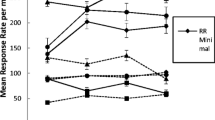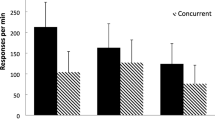Abstract
Thirty-two undergraduates were exposed to a fixed-interval 60-s schedule. There were extreme individual differences in postreinforcement pauses and response rates. Such individual differences persisted for 60 sessions with a total of 1200 reinforcers. The total number of errors made on the Matching Familiar Figures Test was negatively correlated with the postreinforcement pause and positively correlated with the response rate. These results demonstrate that individual differences in human fixed-interval performance are robust and reliable, and relate to impulsiveness.
Similar content being viewed by others
References
BARON, A., KAUFMAN, A., & STAUBER, K. A. (1969). Effects of instructions and reinforcement feedback on human operant behavior maintained by fixed-interval reinforcement. Journal of the Experimental Analysis of Behavior, 12, 701–712.
BARON, A., & PERONE, M. (1998). Experimental design and analysis in the laboratory study of human operant behavior. In K. A. LATTAL & M. PERONE (Eds.), Handbook of research methods in human operant behavior (pp. 45–91). New York: Plenum Press.
BENNETT, R. H., MILLER, H. L., & BUSKIST, W. F. (1984). Human performance on modified fixed-interval schedules. The Psychological Record, 34, 99–114.
BENTALL, R. P., LOWE, C. F., & BEASTY, A. (1985). The role of verbal behavior in human learning: Ii. Developmental differences. Journal of the Experimental Analysis of Behavior, 43, 165–181.
BERNSTEIN, D. J. (1988). Laboratory lore and research practices in the experimental analysis of human behavior: Designing session logistics— How long, how often, how many? The Behavior Analyst, 11, 51–58.
BRESENHAM, J. L, & SHAPIRO, M. M. (1972). Learning strategies in children from different socioeconomic levels. In H.W. REESE (Ed.), Advances in child development and behavior (Vol. 7, pp. 32–79). New York: Academic Press.
BUSKIST, W. R., BENNETT, R. H., & MILLER, H. L (1981). Effects of instructional constraints on human fixed-interval performance. Journal of the Experimental Analysis of Behavior, 35, 217–225.
BUSKIST, W. F., MILLER, H. L, & BENNETT, R. H. (1980). Fixed-interval performance in humans: Sensitivity to temporal parameters when food is the reinforcer. The Psychological Record, 30, 111–121.
DARCHEVILLE, J. C., RIVIERE, V., & WEARDEN, J. H. (1992). Fixed-interval performance and self-control in children. Journal of the Experimental Analysis of Behavior, 57, 187–199.
DARCHEVILLE, J. C., RIVIERE, V., & WEARDEN, J. H. (1993). Fixed-interval performance and self-control in infants. Journal of the Experimental Analysis of Behavior, 60, 239–254.
GALIZIO, M. (1979). Contingency-shaped and rule-governed behavior: Instructional control of human loss avoidance. Journal of the Experimental Analysis of Behavior, 31, 53–70.
GJERDE, P. F., BLOCK, J., & BLOCK, J. H. (1985). Longitudinal consistency of Matching Familiar Figures Test performance from early childhood to preadolescence. Developmental Psychology, 21, 262–271.
GLOW, R. A., LANGE, R. V., GLOW, P. H., & BARNETT, J. A. (1983). Cognitive and self-reported impulsiveness: Comparison of Kagan’s Mfft and Eysenck’s Epq impulsiveness measures. Personality and Individual Differences, 4, 179–187.
HARZEM, P. (1984). Experimental analysis of individual differences and personality. Journal of the Experimental Analysis of Behavior, 42, 385–395.
KAGAN, J. (1966). Reflection-impulsivity: The generality and dynamics of conceptual tempo. Journal of Abnormal Psychology, 71, 17–24.
LEANDER, J. D., LIPPMAN, L. G., & MEYER, M. E. (1968). Fixed interval performance as related to subjects’ verbalizations of the reinforcement contingency. The Psychological Record, 18, 469–474.
LIPPMAN, L. G., & MEYER, M. E. (1967). Fixed-interval performance as related to instructions and to subjects’ verbalizations of the contingency. Psychonomic Science, 8, 135–136.
LOGUE, A. W. (1988). Research on self-control: An integrating framework. Behavioral and Brain Sciences, 11, 665–709.
LOWE, C. F. (1979). Determinants of human operant behaviour. In M. D. ZEILER & P. HARZERN (Eds.), Advances in analysis of behavior: Vol. 1. Reinforcement and the organization of behaviour (pp. 159–192). Chichester, England: Wiley.
MATTHEWS, B. A., SHIMOFF, E., CATANIA, A. C., & SAGVOLDEN, T. (1977). Uninstructed human responding: Sensitivity to ratio and interval contingencies. Journal of the Experimental Analysis of Behavior, 27, 453–467.
OKOUCHI, H. (1993). Ningen no schedule performance (2): Fl performance ni oyobosu hannou cost no kouka [Schedule performance in humans (2): Effects of response cost on the fixed-interval performance]. Proceedings of the 11th meeting of the Japanese Association for Behavior Analysis, 57–58.
ROSENFARB, I.S., BURKER, E. J., MORRIS, S.A., & CUSH, D.T. (1993). Effects of changing contingencies on the behavior of depressed and nondepressed individuals. Journal of Abnormal Psychology, 102, 642–646.
SIDMAN, M. (1960). Tactics of scientific research: Evaluating experimental data in psychology. New York: Basic Books.
SKINNER, B. F. (1938). The behavior of organisms. New York: Appleton-Century-Crofts.
SKINNER, B. F. (1956). A case history in scientific method. American Psychologist, 11, 221–233.
VAN DEN BROEK, M. D, BRADSHAW, C. M., & SZABADI, E. (1987). Behaviour of “impulsive” and “non-impulsive” humans in a temporal differentiation schedule of reinforcement. Personality and Individual Differences, 8, 233–239.
WEINER, H. (1962). Some effects of response cost upon human operant behavior. Journal of the Experimental Analysis of Behavior, 5, 201–208.
WEINER, H. (1964). Response cost effects during extinction following fixed-interval reinforcement in humans. Journal of the Experimental Analysis of Behavior, 7, 333–335.
WEINER, H. (1969). Controlling human fixed-interval performance. Journal of the Experimental Analysis of Behavior, 12, 349–373.
WULFERT, E., GREENWAY, D. E., FARKAS, P., HAYES, S. C., & DOUGHER, M. J. (1994). Correlation between self-reported rigidity and rule-governed insensitivity to operant contingencies. Journal of Applied Behavior Analysis, 27, 659–671.
Author information
Authors and Affiliations
Corresponding author
Rights and permissions
About this article
Cite this article
Okouchi, H. Individual Differences in Human Fixed-Interval Performance. Psychol Rec 52, 173–186 (2002). https://doi.org/10.1007/BF03395422
Published:
Issue Date:
DOI: https://doi.org/10.1007/BF03395422




